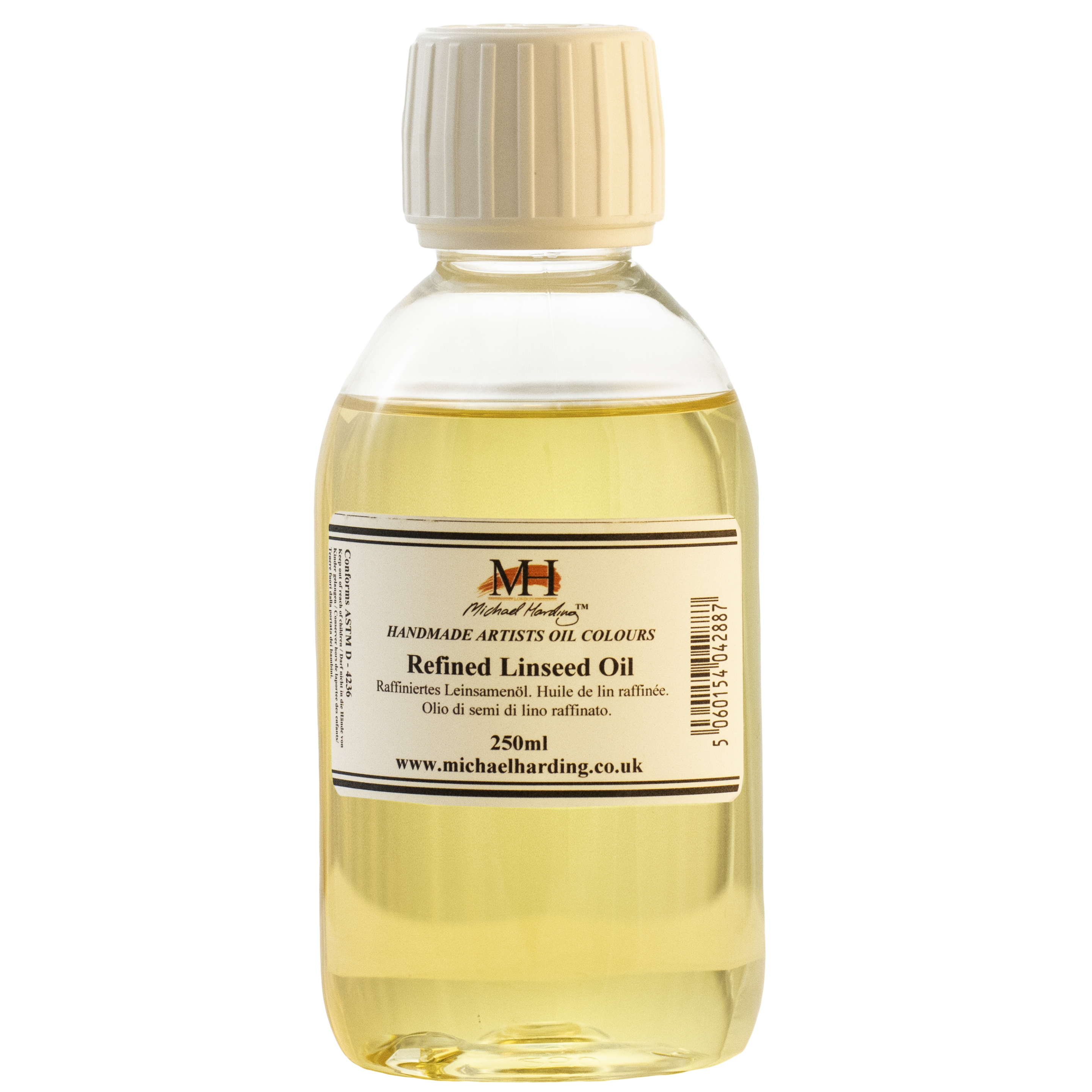Oils – For Oil Painting
Refined Linseed Oil
Ⓥ VEGAN
When mixed with oil paint, Michael Harding’s linseed oil increases the gloss and transparency of the paint, thins the paint for easier flow, and reduces visible brush marks. It also slows the drying time of the paint. However, using too much can cause yellowing due to the natural color of the oil and can lead to defects like wrinkling if layers are applied too thickly.
Alkali Refined Pale Linseed Oil, a pale oil extracted from flax seeds, is used in many of Michael Harding’s paints. This oil ensures a strong paint film during drying, contributing to the longevity of each painting. It is also suitable for use with dry ground pigments.
Please note: Soft materials soaked in linseed oil should be stored in sealed containers to prevent oxidation, which can generate heat and potentially cause spontaneous combustion. Ensure the container is securely closed and stored in a cool place. Brushes and tools used with linseed oil should be cleaned with white spirit.
Michael Harding’s Refined Linseed Oil is crafted from the finest materials. Michael Harding continually develops, tests, and releases new artist supplies, maintaining a commitment to sourcing the highest quality materials. Using Michael Harding products means working with materials that meet the standards of the Old Masters, combined with modern innovation.

SAFETY NOTE: Soft materials that have absorbed linseed oil should be stored in sealed containers, as the oil will oxidise when exposed to air. This chemical reaction releases so much heat that rags may spontaneously combust. Make sure the lid of the container is closed securely and stored in a cool place. Brushes and tools used with linseed oil should be cleaned thoroughly with white spirit.
Key Features:
Key Features:
- Increases gloss and transparency
- Produces a strong, durable paint film
- Available in 100ml, 250ml, and 1000ml sizes
- Professional quality
- Made with refined linseed oil
- Improves paint consistency
- Made in the UK
Guide for Use:
You can add linseed oil to your oil paints to increase flow; however, an excess will lead to some yellowing due to the natural colour of the oil. Apply the paint layers thinly to avoid other defects of excess, such as wrinkling
Using Michael Harding Linseed Oil in the Fat Over Lean Technique
Materials Needed:
- Michael Harding Linseed Oil
- Oil paints
- Palette or mixing surface
- Palette knife or mixing tool
- Brushes
- White spirit (for cleaning brushes and tools) or Miracle Medium/Washing up Liquid.
- Sealed container (for storing used rags or materials)
Steps:
-
Understand the Fat Over Lean Principle:
- The fat over lean technique involves applying layers of oil paint with increasing oil content (fat) over layers with less oil content (lean). This ensures that the top layers remain flexible as the painting dries, preventing cracks.
-
Prepare Your Workspace:
- Set up a clean, well-lit area with proper ventilation.
- Arrange your oil paints, linseed oil, palette, brushes, and other tools within easy reach.
-
Initial Lean Layers:
- Start with your leanest layers, which should contain minimal or no linseed oil. Use straight oil paint or mix with a solvent like turpentine or mineral spirits to thin the paint.
-
Mix Lean Paint:
- Squeeze the desired amount of oil paint onto your palette or mixing surface.
- Add a small amount of solvent to the paint and mix thoroughly with a palette knife. This will thin the paint without adding oil, making it lean.
-
Apply Lean Layers:
- Use your brushes to apply these lean layers to your canvas. Allow each layer to dry completely before adding the next.
-
Introduce Linseed Oil for Middle Layers:
- As you progress to the middle layers, start incorporating small amounts of Michael Harding Linseed Oil.
- Mix a small amount of linseed oil with your paint on the palette. This will add some fat to the paint while keeping it relatively lean compared to the top layers.
-
Mix and Apply Middle Layers:
- Blend the linseed oil into the paint with a palette knife until you achieve a smooth, slightly more fluid consistency.
- Apply these middle layers over the lean layers, ensuring each layer dries thoroughly before adding the next.
-
Final Fat Layers:
- For the topmost layers, increase the amount of linseed oil to make the paint fatter.
- Squeeze out your oil paint and add a generous amount of linseed oil to it. Mix well with a palette knife.
-
Mix and Apply Fat Layers:
- The paint should be noticeably glossier and more transparent. Apply these fat layers over the previous ones.
- Ensure that each layer dries thoroughly before applying the next to maintain the integrity of the fat over lean principle.
-
Clean Your Tools:
- After painting, clean your brushes and tools with white spirit to remove any remaining linseed oil and paint.
-
Store Used Materials Safely:
- Place any rags or materials soaked with linseed oil into a sealed container to prevent oxidation, which can cause spontaneous combustion.
- Ensure the container lid is securely closed and store it in a cool place.
-
Monitor Drying Time:
- Remember that adding linseed oil slows the drying time. Be patient and allow each layer to dry completely before applying the next.
By following these steps, you can effectively use Michael Harding Linseed Oil to adhere to the fat over lean technique, ensuring a flexible and durable painting structure.
Important Note:
During the winter months, it is entirely normal for linseed oil to undergo a process known as clouding or thickening due to the lower temperatures. Linseed oil contains fatty acids that can solidify or become more viscous in colder conditions. This natural occurrence does not affect the quality of the oil; however, it can make application challenging. To address this issue, simply warm the linseed oil before use. Placing the container in a warm water bath or exposing it to a slightly elevated temperature will help restore the oil to its liquid state, making it easier to apply and ensuring that it maintains its desirable properties. This simple step allows for a smoother application of linseed oil, preserving its effectiveness
